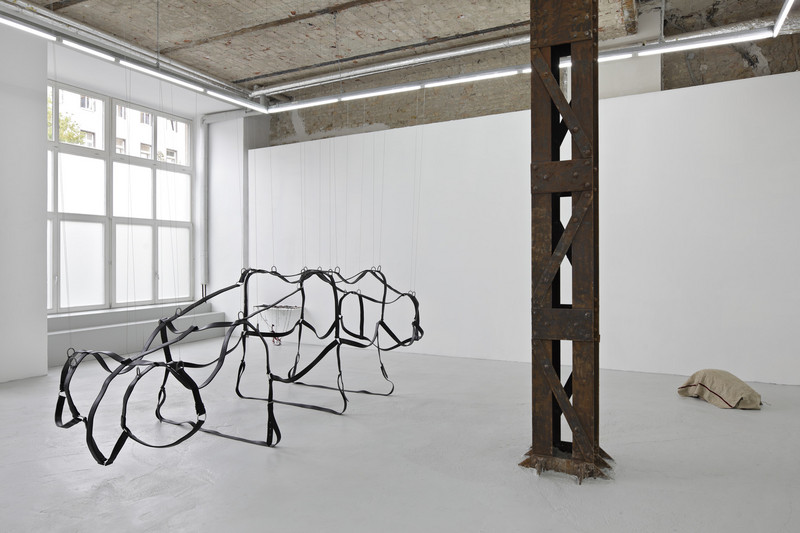Anca Munteanu Rimnic
03 - 28 Sep 2013
ANCA MUNTEANU RIMNIC
Lament
3 - 28 September 2013
Anca Munteanu Rimnic’s recent exhibition presents two new major works by the artist, who was born in Bucharest in 1974 and lives in Berlin. Lament III (Museum Curator Collector) and Lament V (Empty Bags) (both 2013) are two sequences from the eight-part video Lament I-VIII.
Munteanu Rimnic hired six Romanian wailers; the women exclaim words the artist chose for the choreographed performance and then break out in loud lamentation. In Romania, especially in rural areas, the tradition survives that women mourn the deceased. The mourners used to be recruited from the family of the dead person, but now it is customary to hire professional wailers
Instead of the name of a deceased they never knew, they exclaim words that are just as unfamiliar to them because they come from the alien world in which the artist lives: MUSEUM CURATOR COLLECTOR. So they feign not only grief, but also familiarity with institutions and people who are now indispensable parts of the art system. Munteanu Rimnic is afraid of failing in their eyes, and so she, too, would prefer to remain unacquainted with these art market protagonists, yet as she cannot but admit, she has long become dependent on them. Do the wailers ultimately also mourn the artist’s independence, which success in the art market would compromise forever?
Wild Worses (2013) is an outsize horse’s harness made of sturdy leather, but it is far too large for a horse. Its dimensions make it more suitable for a stately luxury vehicle, which it would fit perfectly and whose contours the installation suspended from the ceiling in fact vaguely suggests. In the Romania of Anca Munteanu Rimnic’s early childhood, horse-drawn carts were commonplace, in contrast with the Lada cars that only members of the privileged class owned.
Even today, a Western luxury car embodies the aspirations of many of her compatriots. And so Wild Worses reflects dreams as well as traumas, the effort to come to terms with the past as well as the belief in progress. The satisfaction of the desire for a consumer product, be it the cherry-liqueur pralines the residents of the Eastern Bloc craved for or a car sold in the free market, soon gives way to new desires.
After leaving their native country and finding refuge in the supposedly free world, Romanians inevitably struggled with capitalism and its excesses. With this minimalist and yet profoundly moving sculpture, the artist evokes an image of bridled yearnings and desires kept in check. The inner conflict between the impulse to run away and the pressure to submit to the strictures of pervasive conventions has been Munteanu Rimnic’s constant companion. Uta Grosenick
Lament
3 - 28 September 2013
Anca Munteanu Rimnic’s recent exhibition presents two new major works by the artist, who was born in Bucharest in 1974 and lives in Berlin. Lament III (Museum Curator Collector) and Lament V (Empty Bags) (both 2013) are two sequences from the eight-part video Lament I-VIII.
Munteanu Rimnic hired six Romanian wailers; the women exclaim words the artist chose for the choreographed performance and then break out in loud lamentation. In Romania, especially in rural areas, the tradition survives that women mourn the deceased. The mourners used to be recruited from the family of the dead person, but now it is customary to hire professional wailers
Instead of the name of a deceased they never knew, they exclaim words that are just as unfamiliar to them because they come from the alien world in which the artist lives: MUSEUM CURATOR COLLECTOR. So they feign not only grief, but also familiarity with institutions and people who are now indispensable parts of the art system. Munteanu Rimnic is afraid of failing in their eyes, and so she, too, would prefer to remain unacquainted with these art market protagonists, yet as she cannot but admit, she has long become dependent on them. Do the wailers ultimately also mourn the artist’s independence, which success in the art market would compromise forever?
Wild Worses (2013) is an outsize horse’s harness made of sturdy leather, but it is far too large for a horse. Its dimensions make it more suitable for a stately luxury vehicle, which it would fit perfectly and whose contours the installation suspended from the ceiling in fact vaguely suggests. In the Romania of Anca Munteanu Rimnic’s early childhood, horse-drawn carts were commonplace, in contrast with the Lada cars that only members of the privileged class owned.
Even today, a Western luxury car embodies the aspirations of many of her compatriots. And so Wild Worses reflects dreams as well as traumas, the effort to come to terms with the past as well as the belief in progress. The satisfaction of the desire for a consumer product, be it the cherry-liqueur pralines the residents of the Eastern Bloc craved for or a car sold in the free market, soon gives way to new desires.
After leaving their native country and finding refuge in the supposedly free world, Romanians inevitably struggled with capitalism and its excesses. With this minimalist and yet profoundly moving sculpture, the artist evokes an image of bridled yearnings and desires kept in check. The inner conflict between the impulse to run away and the pressure to submit to the strictures of pervasive conventions has been Munteanu Rimnic’s constant companion. Uta Grosenick

